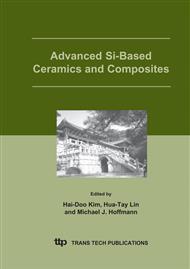p.265
p.271
p.277
p.282
p.293
p.299
p.311
p.317
p.323
Influence of Amount of Nitrogen on Crystallisation of Y-SiAlON Glasses: In Situ XRD Analysis
Abstract:
Y-SiAlON glasses of composition 36.5 Y: 42.3 Si: 21.2 Al with different amounts of N (0, 5, 8, 15 and 22 in e/o) were produced by melting appropriate mixtures of powders under flowing nitrogen at 1715°C. This composition is known to give B-phase (Y2SiAlO5N) on crystallisation at temperatures below 1050°C. In this work, the effect of nitrogen in the starting glass composition on the crystalline phases formed is discussed. High temperature in-situ XRD analysis was performed on powdered glass samples up to 1150°C by using a Philips X’pert PRO MPD (Multi Purpose Diffractometer) with a HTK1200 Oven Camera (Anton Paar, Austria). As expected, the results show that different nitrogen contents affect the crystalline phases formed. In all glasses, yttrium apatite silicate forms first, followed by crystallisation of B-phase. The phase transformation from B-phase to Iw-phase (Y3Si2Al[O,N10] i.e. 10 e/o N) takes place at relatively low temperatures (1050°C) for the lower nitrogen containing samples (5 and 8 e/o), whereas, the transformation does not take place for the glasses with higher nitrogen contents even at the maximum temperature studied (1150°C). This work also confirms that there is a correlation between the temperature where the first crystals appear and the amount of nitrogen in the starting glass.
Info:
Periodical:
Pages:
293-298
Citation:
Online since:
June 2005
Authors:
Keywords:
Price:
Сopyright:
© 2005 Trans Tech Publications Ltd. All Rights Reserved
Share:
Citation:


